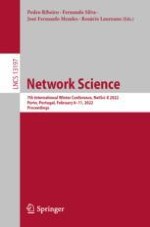2022 | Buch
Network Science
7th International Winter Conference, NetSci-X 2022, Porto, Portugal, February 8–11, 2022, Proceedings
herausgegeben von: Pedro Ribeiro, Fernando Silva, José Fernando Mendes, Rosário Laureano
Verlag: Springer International Publishing
Buchreihe : Lecture Notes in Computer Science
